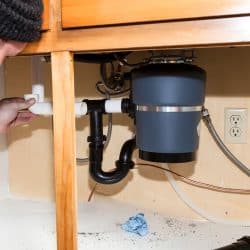Top Methods for Resolving a Leak in Your Garbage Disposal
Top Methods for Resolving a Leak in Your Garbage Disposal
Blog Article
Just how do you really feel on the subject of The Handy Guide To Fixing Your Garbage Disposal Leaking?

Garbage disposals are essential kitchen area appliances that assist in dealing with food waste successfully. Nevertheless, a dripping garbage disposal can be a discouraging and unpleasant issue to deal with. Luckily, several leakages can be repaired conveniently with a couple of simple actions. In this article, we will discuss how to take care of a dripping waste disposal unit effectively.
Introduction
Waste disposal unit are mounted under kitchen sinks and are developed to shred food waste right into smaller pieces, enabling it to travel through the pipes system conveniently. While these tools are generally trustworthy, leakages can happen in time due to deterioration, loose links, or damages to the unit.
Common Causes of Leakages in Rubbish Disposals
Worn Seals and Gaskets
Seals and gaskets play a critical role in stopping water from leaking out of the waste disposal unit. In time, these parts can weaken, bring about leaks around the disposal device.
Loose Links
The connections between the garbage disposal and the plumbing system can come to be loose in time, causing water to leak out during procedure.
Splits or Holes in the Disposal Device
Physical damages to the waste disposal unit, such as cracks or holes in the real estate, can likewise lead to leakages.
Recognizing the Resource of the Leakage
Prior to trying to take care of a dripping waste disposal unit, it is vital to recognize the resource of the leakage. This can typically be done via aesthetic evaluation or by carrying out easy examinations.
Visual Evaluation
Examine the waste disposal unit unit thoroughly for any type of indicators of water leakage. Pay close attention to locations around seals, gaskets, and connection points.
Examining for Leakages
One way to check for leakages is by running water via the disposal device and checking for any noticeable indicators of leak.
Devices and Products Needed for Fixing a Leaking Garbage Disposal
Prior to beginning the fixing process, collect the essential devices and products, consisting of a screwdriver, adjustable wrench, plumbing professional's putty, replacement seals or gaskets, and epoxy or patching product for fixing splits or holes.
Step-by-Step Overview to Dealing With a Dripping Garbage Disposal
Switch off the Power
Before attempting any kind of repair services, ensure that the power to the waste disposal unit system is shut off to prevent the danger of electrical shock.
Locate the Leak
Recognize the exact place of the leakage and identify the cause.
Tighten up Links
Make use of a wrench to tighten any kind of loosened connections in between the disposal system and the pipes system.
Replace Seals or Gaskets
If the leakage is because of used seals or gaskets, get rid of the old components and replace them with brand-new ones.
Patching Cracks or Holes
For cracks or holes in the disposal unit, use epoxy or an appropriate patching product to secure the damaged location.
Examining the Waste Disposal Unit After Repair Service
When the repair work is full, check the waste disposal unit by running water with it to ensure that the leakage has been resolved.
Preventive Upkeep Tips to Avoid Future Leaks
To prevent future leakages, it is important to carry out normal maintenance on your garbage disposal. This consists of keeping it clean, avoiding placing non-food things or difficult items down the disposal, and periodically looking for leakages or various other issues.
Final thought
Finally, fixing a leaking garbage disposal is a fairly straightforward process that can be completed with fundamental tools and materials. By adhering to the steps laid out in this write-up and exercising preventative upkeep, you can maintain your waste disposal unit in good working condition and stay clear of pricey fixings in the future.
HERE’S HOW TO FIX YOUR GARBAGE DISPOSAL
WHAT TO DO IF SOMETHING IS STUCK IN YOUR GARBAGE DISPOSAL
If the impeller won’t turn, there’s probably something stuck in the disposal. It could be a steak bone or peach pit, although plumbers report pulling all sorts of inappropriate objects out of disposals, such as bottle caps or aluminum foil. Make sure power to the disposal is off, and look inside to see if you can see the source of the jam.
Never stick your fingers in a disposal. Pull out anything you see with tongs or pliers.
If the disposal still won’t work, it may be time to call a plumber or consider buying a new disposal. GEM Plumbing & Heating is here for all of your garbage disposal needs.
WHAT TO DO IF YOUR GARBAGE DISPOSAL DRAIN IS CLOGGED
Take everything out from underneath your sink and put a bucket or other container under your disposal to catch any water that drains out. Disconnect your disposal from the power supply. If it’s plugged into a wall outlet, unplug it. If it’s hardwired into an electrical box, go to the electrical panel and turn off the breaker for the disposal. Pour ¼ cup of baking soda into the drain, followed by ½ cup of white vinegar. Give the solution a few minutes to fizz and do its work. Look into the disposal with a flashlight to see if you can see an object that might be causing the clog. If you see it, remove it using tongs or pliers. MORE TIPS ON DEALING WITH A CLOGGED GARBAGE DISPOSAL
Never use drain cleaner in a garbage disposal. It can damage the plastic parts inside the disposal. You can also be splashed with the caustic liquid while working to clear the clog. Beware! Never stick your fingers into a garbage disposal. Trust us — not a good idea. In many instances, your dishwasher drains through your garbage disposal. This allows the disposal to grind any large food particles that may be drained out of your dishwasher. There are some jurisdictions, however, where the plumbing code prohibits such a connection. WHAT TO DO WHEN YOUR DISHWASHER DRAINS THROUGH THE DISPOSAL
Run some water in the sink so your plunger has at least a ½-inch of water to create a seal and plunge vigorously up and down several times. You may need to repeat this several times. Run hot water down the drain to clear any residue that remains.

Do you really like reading up on Why Is ? Leave a short review directly below. We would be glad to know your reactions about this article. In hopes to see you back again before long. Sharing is caring. Helping others is fun. Bless you for your time. Kindly pay a visit to our website back soon.
Suggested Site Report this page